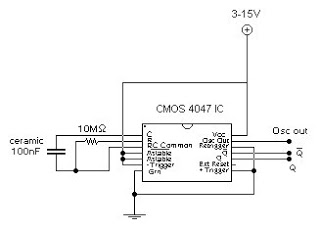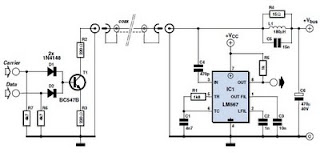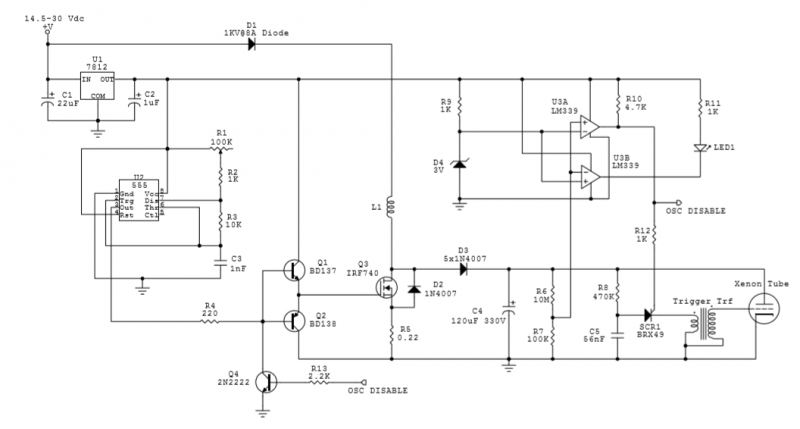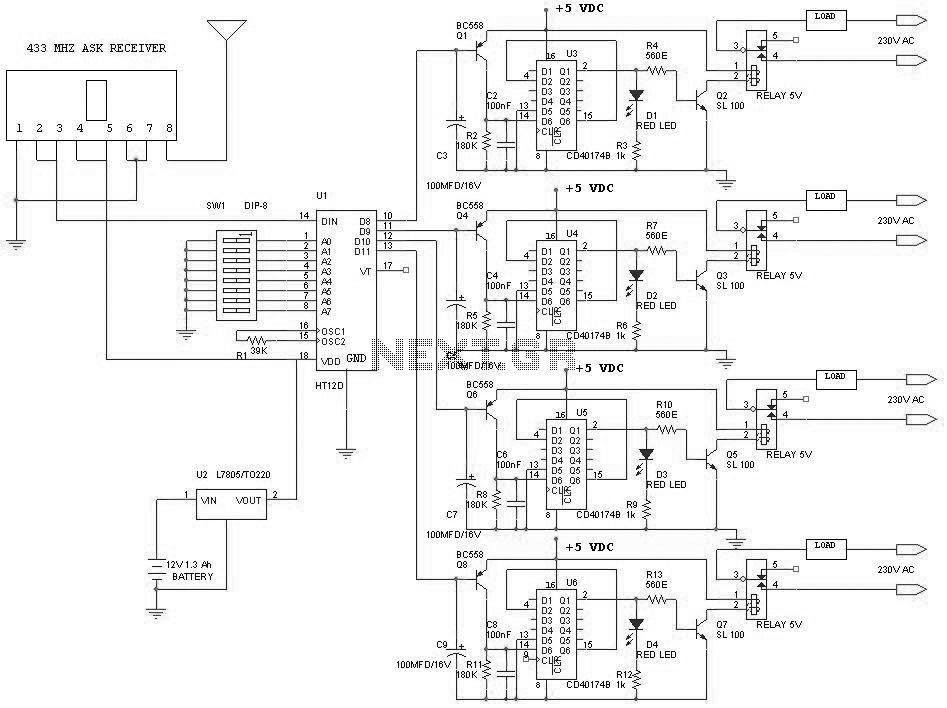
radio remote control RC using DTMF circuit diagram

This circuit represents a remote control unit that utilizes radio frequency signals to operate various electrical appliances. The remote control unit features four channels, which can be expanded to twelve. This circuit stands out from similar designs due to its simplicity and a unique method of generating control signals. Unlike conventional remote control circuits that rely on infrared light for signal transmission, which limits their effectiveness to a confined area and requires a direct line-of-sight, this circuit employs radio frequency for signal transmission, allowing control from nearly any location within a house. The control codes are based on DTMF (dual-tone multi-frequency) signals, commonly used in telephones for dialing. DTMF tones are utilized for frequency modulation of a carrier signal. At the receiver end, these frequency-modulated signals are captured to retrieve DTMF tones at the speaker terminals. The DTMF signal is then connected to a DTMF-to-BCD converter, with the BCD output used to switch electrical appliances on and off (four in this instance). The remote control transmitter consists of a DTMF generator and an FM transmitter circuit. A dedicated IC, the UM91214B, which functions as a dialer IC in telephone instruments, is used to generate the DTMF frequencies. This IC operates at 3 volts, supplied by a simple zener diode voltage regulator that converts 9 volts to 3 volts. A quartz crystal of 3.58 MHz is required for the IC's time base, which is readily available from electronic component suppliers. Pins 1 and 2 serve as chip select and DTMF mode select pins, respectively. When the row and column pins (12 and 15) are connected, DTMF tones corresponding to digit 1 are output from pin 7. Similarly, pins 13, 16, and 17 are used to dial digits 2, 4, and 8. The remaining pins of this IC can be left unconnected. The output from IC1 is directed to the transmitter circuit input, which effectively frequency modulates the carrier and transmits the signal. The carrier frequency is determined by coil L1 and trimmer capacitor VC1, which can be adjusted for operation around 100 MHz. An antenna of 10 to 15 cm (4 to 6 inches) in length is sufficient for adequate range and is necessary as the transmitter unit should be housed in a metallic cabinet to mitigate frequency drift caused by stray electromagnetic fields. Four key switches (DPST push-to-on spring-loaded) are required to transmit the desired DTMF tones. When pressed, these switches generate specific tone pairs while simultaneously powering the transmitter circuit. This design ensures that when the transmitter is not in use, it consumes no power, thereby extending battery life. The receiver unit comprises an FM receiver (which is now easily available in simple and inexpensive kits), a DTMF-to-BCD converter, and a flip-flop toggling latch section. The frequency-modulated DTMF signals are received by the FM receiver, and the output (DTMF tones) is fed to the dedicated IC KT3170, a DTMF-to-BCD converter. This IC produces the corresponding BCD output when fed DTMF tones; for instance, pressing digit 1 results in an output of 0001, while pressing digit 4 yields 0100. The IC also requires a 3.58 MHz crystal for operation. The tone input connects to pin 2, and the BCD outputs are taken from pins 11 to 14. These outputs are then directed to four individual D flip-flop latches, which have been configured as toggle flip-flops using two CD4013B ICs. Each time a digit is pressed, the receiver decodes it and generates a clock pulse that toggles the corresponding flip-flop to an alternate state. The output from the flip-flop drives a relay, which can latch or unlatch any electrical appliance. The circuit can be upgraded to control up to twelve channels, as the UM91214B can generate 12 DTMF tones. For this enhancement, modifications are necessary in the receiver unit, as well as between IC2 and the toggle flip-flop section. A 4-to-16 line demultiplexer (IC 74154) must be incorporated, and the number of toggle flip-flops should be increased from four to twelve.Here is a circuit of a remote control unit which makes use of the radio frequency signals to control various electrical appliances. This remote control unit has 4 channels which can be easily extended to 12. This circuit differs from similar circuits in view of its simplicity and a totally different concept of generating the control signals.
Usual ly remote control circuits make use of infrared light to transmit control signals. Their use is thus limited to a very confined area and line-of-sight. However, this circuit makes use of radio frequency to transmit the control signals and hence it can be used for control from almost anywhere in the house. Here we make use of DTMF (dual-tone multi frequency) signals (used in telephones to dial the digits) as the control codes.
The DTMF tones are used for frequency modulation of the carrier. At the receiver unit, these frequency modulated signals are intercepted to obtain DTMF tones at the speaker terminals. This DTMF signal is connected to a DTMF-to-BCD converter whose BCD output is used to switch-on and switch-off various electrical applicances (4 in this case).
The remote control transmitter consists of DTMF generator and an FM transmitter circuit. For generating the DTMF frequencies, a dedicated IC UM91214B (which is used as a dialler IC in telephone instruments) is used here. This IC requires 3 volts for its operation. This is provided by a simple zener diode voltage regulator which converts 9 volts into 3 volts for use by this IC.
For its time base, it requires a quartz crystal of 3. 58 MHz which is easily available from electronic component shops. Pins 1 and 2 are used as chip select and DTMF mode select pins respectively. When the row and column pins (12 and 15) are shorted to each other, DTMF tones corresponding to digit 1 are output from its pin 7. Similarly, pins 13, 16 and 17 are additionally required to dial digits 2, 4 and 8. Rest of the pins of this IC may be left as they are. The output of IC1 is given to the input of this transmitter circuit which effectively frequency modulates the carrier and transmits it in the air.
The carrier frequency is determined by coil L1 and trimmer capacitor VC1 (which may be adjusted for around 100MHz operation). An antenna of 10 to 15 cms (4 to 6 inches) length will be sufficient to provide adequate range. The antenna is also necessary because the transmitter unit has to be housed in a metallic cabinet to protect the frequency drift caused due to stray EM fields.
Four key switches (DPST push-to-on spring loaded) are required to transmit the desired DTMF tones. The switches when pressed generate the specific tone pairs as well as provide power to the transmitter circuit simultaneously. This way when the transmitter unit is not in use it consumes no power at all and the battery lasts much longer.
The receiver unit consists of an FM receiver (these days simple and inexpensive FM kits are readily available in the market which work exceptionally well), a DTMF-to-BCD converter and a flip-flop toggling latch section. The frequency modulated DTMF signals are received by the FM receiver and the output (DTMF tones) are fed to the dedicated IC KT3170 which is a DTMF-to-BCD converter.
This IC when fed with the DTMF tones gives corresponding BCD output; for example, when digit 1 is pressed, the output is 0001 and when digit 4 is pressed the output is 0100. This IC also requires a 3. 58MHz crystal for its operation. The tone input is connected to its pin 2 and the BCD outputs are taken from pins 11 to 14 respectively.
These outputs are fed to 4 individual D flip-flop latches which have been converted into toggle flip-flops built around two CD4013B ICs. Whenever a digit is pressed, the receiver decodes it and gives a clock pulse which is used to toggle the corresponding flip-flop to the alternate state.
The flip-flop output is used to drive a relay which in turn can latch or unlatch any electrical appliance. We can upgrade the circuit to control as many as 12 channels since IC UM91214B can generates 12 DTMF tones.
For this purpose some modification has to be done in receiver unit and also in between IC2 and toggle flip-flop section in the receiver. A 4-to-16 lines demultiplexer (IC 74154) has to be used and the number of toggle flip-flops have also to be increased to 12 from the existing 4 Disclaimer: All the information present on this site are for personal use only.
No commercial use is permitted without the prior permission from authors of this website. All content on this site is provided as is and without any guarantee on any kind, implied or otherwise. We cannot be held responsible for any errors, omissions, or damages arising out of use of information available on this web site.
The content in this site may contain COPYRIGHTED information and should not be reproduced in any way without prior permission from the authors. 🔗 External reference
Usual ly remote control circuits make use of infrared light to transmit control signals. Their use is thus limited to a very confined area and line-of-sight. However, this circuit makes use of radio frequency to transmit the control signals and hence it can be used for control from almost anywhere in the house. Here we make use of DTMF (dual-tone multi frequency) signals (used in telephones to dial the digits) as the control codes.
The DTMF tones are used for frequency modulation of the carrier. At the receiver unit, these frequency modulated signals are intercepted to obtain DTMF tones at the speaker terminals. This DTMF signal is connected to a DTMF-to-BCD converter whose BCD output is used to switch-on and switch-off various electrical applicances (4 in this case).
The remote control transmitter consists of DTMF generator and an FM transmitter circuit. For generating the DTMF frequencies, a dedicated IC UM91214B (which is used as a dialler IC in telephone instruments) is used here. This IC requires 3 volts for its operation. This is provided by a simple zener diode voltage regulator which converts 9 volts into 3 volts for use by this IC.
For its time base, it requires a quartz crystal of 3. 58 MHz which is easily available from electronic component shops. Pins 1 and 2 are used as chip select and DTMF mode select pins respectively. When the row and column pins (12 and 15) are shorted to each other, DTMF tones corresponding to digit 1 are output from its pin 7. Similarly, pins 13, 16 and 17 are additionally required to dial digits 2, 4 and 8. Rest of the pins of this IC may be left as they are. The output of IC1 is given to the input of this transmitter circuit which effectively frequency modulates the carrier and transmits it in the air.
The carrier frequency is determined by coil L1 and trimmer capacitor VC1 (which may be adjusted for around 100MHz operation). An antenna of 10 to 15 cms (4 to 6 inches) length will be sufficient to provide adequate range. The antenna is also necessary because the transmitter unit has to be housed in a metallic cabinet to protect the frequency drift caused due to stray EM fields.
Four key switches (DPST push-to-on spring loaded) are required to transmit the desired DTMF tones. The switches when pressed generate the specific tone pairs as well as provide power to the transmitter circuit simultaneously. This way when the transmitter unit is not in use it consumes no power at all and the battery lasts much longer.
The receiver unit consists of an FM receiver (these days simple and inexpensive FM kits are readily available in the market which work exceptionally well), a DTMF-to-BCD converter and a flip-flop toggling latch section. The frequency modulated DTMF signals are received by the FM receiver and the output (DTMF tones) are fed to the dedicated IC KT3170 which is a DTMF-to-BCD converter.
This IC when fed with the DTMF tones gives corresponding BCD output; for example, when digit 1 is pressed, the output is 0001 and when digit 4 is pressed the output is 0100. This IC also requires a 3. 58MHz crystal for its operation. The tone input is connected to its pin 2 and the BCD outputs are taken from pins 11 to 14 respectively.
These outputs are fed to 4 individual D flip-flop latches which have been converted into toggle flip-flops built around two CD4013B ICs. Whenever a digit is pressed, the receiver decodes it and gives a clock pulse which is used to toggle the corresponding flip-flop to the alternate state.
The flip-flop output is used to drive a relay which in turn can latch or unlatch any electrical appliance. We can upgrade the circuit to control as many as 12 channels since IC UM91214B can generates 12 DTMF tones.
For this purpose some modification has to be done in receiver unit and also in between IC2 and toggle flip-flop section in the receiver. A 4-to-16 lines demultiplexer (IC 74154) has to be used and the number of toggle flip-flops have also to be increased to 12 from the existing 4 Disclaimer: All the information present on this site are for personal use only.
No commercial use is permitted without the prior permission from authors of this website. All content on this site is provided as is and without any guarantee on any kind, implied or otherwise. We cannot be held responsible for any errors, omissions, or damages arising out of use of information available on this web site.
The content in this site may contain COPYRIGHTED information and should not be reproduced in any way without prior permission from the authors. 🔗 External reference





